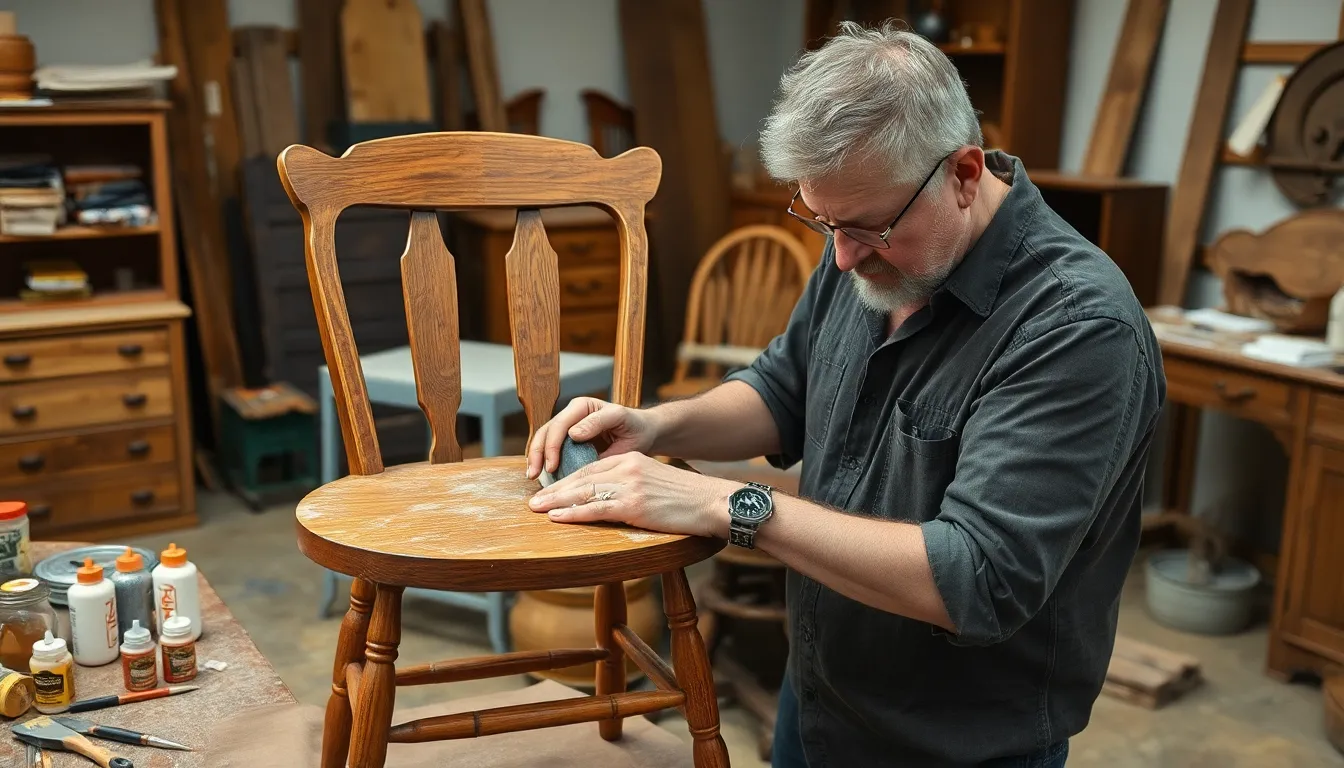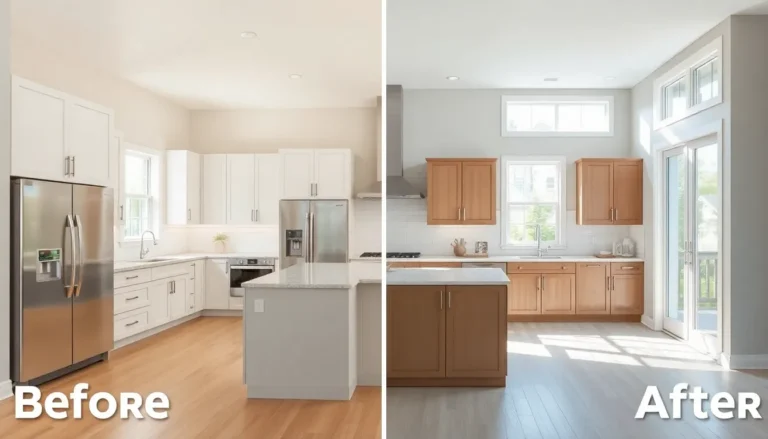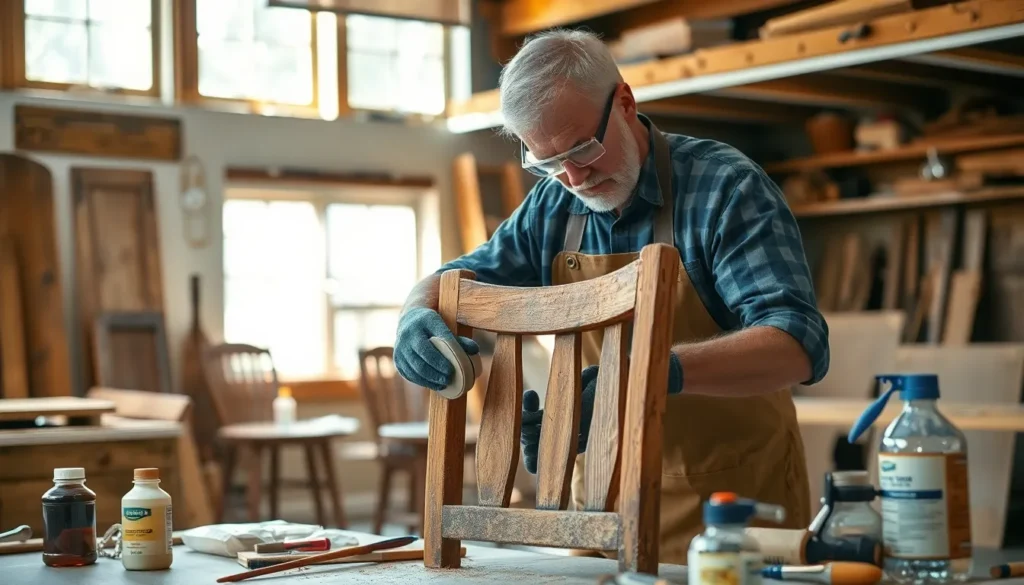Table of Contents
ToggleFurniture restoration breathes new life into cherished pieces, transforming them from worn and tired to stunning and functional. It’s not just about aesthetics; it’s a sustainable practice that preserves memories and history, allowing families to pass down heirlooms for generations. With a few tools and techniques, anyone can embark on this rewarding journey.
Whether it’s a vintage chair, a weathered table, or a beloved dresser, each item tells a story waiting to be revived. The art of restoration combines creativity with craftsmanship, enabling individuals to personalize their spaces while honoring the past. By exploring various methods and materials, furniture restoration opens up a world of possibilities, making it an appealing choice for DIY enthusiasts and professionals alike.
What Is Furniture Restoration?
Furniture restoration involves the careful process of repairing, refinishing, and revitalizing old or damaged furniture. This practice not only enhances the appearance of pieces but also maintains their historical significance and durability.
Definition and Purpose
Furniture restoration refers to the techniques used to restore furniture to its original condition or a condition that reflects its historical period. The primary purpose includes preserving quality, repairing structural issues, and enhancing the aesthetic appeal of items. Key techniques include refinishing surfaces, repairing joints, replacing parts, and restoring upholstery. By focusing on these aspects, furniture restoration aims to extend the life of cherished pieces and retain their emotional value.
Benefits of Furniture Restoration
Furniture restoration offers several notable benefits:
- Sustainability: Restoring furniture reduces waste by keeping items out of landfills.
- Cost-effectiveness: Restoring existing pieces often costs less than purchasing new furniture.
- Preservation of heritage: Restored items retain their historical and sentimental value, allowing stories to be passed through generations.
- Customization: Revitalizing furniture provides opportunities for customization to fit personal tastes and current trends.
- Skill development: Engaging in restoration projects helps develop craftsmanship and problem-solving skills, beneficial for both DIY enthusiasts and professionals.
Through these benefits, furniture restoration stands as a rewarding practice that combines creativity with practical benefit.
Types of Furniture Restoration

Furniture restoration includes several approaches that cater to different needs and goals. The primary types are cosmetic and structural restoration, each focusing on specific aspects of furniture preservation.
Cosmetic Restoration
Cosmetic restoration enhances the visual appeal of furniture without altering its essential structure. This process includes refinishing surfaces, applying new finishes, and cleaning to remove dirt and grime. Techniques such as sanding and staining breathe new life into worn finishes. For example, a weathered wooden chair may receive a fresh coat of paint or varnish to restore its original luster. Upholstery repairs also fall under this category, where worn-out fabric is replaced or reupholstered, keeping the piece functional and aesthetically pleasing. Cosmetic restoration helps maintain the character of the furniture while offering a fresh look.
Structural Restoration
Structural restoration addresses the integrity and functionality of furniture. This process involves repairing joints, fixing broken components, and replacing damaged parts to ensure the piece’s longevity. For instance, a wobbly table may undergo joint reinforcing or leg replacement to restore stability. This type of restoration often requires woodworking skills and knowledge of furniture construction methods. Additionally, structural restoration preserves the overall durability of the item while retaining its historical significance. It is essential for maintaining the furniture’s usability while allowing it to withstand the test of time.
Common Techniques in Furniture Restoration
Furniture restoration employs various techniques that enhance the appearance and functionality of pieces while preserving their history. Here are some common methods used in the restoration process.
Stripping and Sanding
Stripping removes old finishes, paint, or varnish, revealing the underlying wood. Professionals typically use chemical strippers or heat guns for this process. Once stripped, sanding smooths the surface, removes imperfections, and prepares it for finishing. Sanding involves using various grit levels, starting with a coarse grit for heavy removal and progressing to a fine grit for a polished finish.
Staining and Finishing
Staining adds color to wood while allowing its natural grain to show. Application methods include brushes, rags, or spray systems, with drying times varying based on the product used. Finishing involves applying protective coatings like lacquer or polyurethane to enhance durability and provide a luster. Various types of finishes exist, including matte, satin, and gloss, allowing customization based on desired aesthetics.
Reupholstering
Reupholstering transforms the look and comfort of furniture by replacing old fabrics with new ones. This process involves removing the old upholstery, repairing any damage to the underlying structure, and adding new padding as needed. Fabric choices range widely, from durable synthetics to luxurious natural fibers, allowing for personal style in every restoration project.
Tools and Materials Needed
Engaging in furniture restoration requires specific tools and materials to ensure effective and efficient work. Below is a comprehensive list of essential tools and recommended materials necessary for successful restoration projects.
Essential Tools for Restoration
- Screwdrivers: Varied sizes and types, including flathead and Phillips, facilitate disassembly and reassembly of furniture.
- Hammer: A claw hammer aids in removing nails and securing joints during repairs.
- Pliers: Needle-nose and standard pliers assist in gripping, twisting, and cutting wires or small components.
- Drill: A power drill speeds up drilling holes for screws and fastening parts securely.
- Saw: A miter or hand saw is useful for cutting wood pieces when replacing or repairing components.
- Sander: Orbital or belt sanders effectively smooth surfaces and prepare wood for refinishing.
- Paintbrushes and Rollers: Different sizes of brushes and rollers apply stains, paints, and finishes uniformly.
- Putty Knife: This tool is essential for applying wood filler and smoothing surfaces.
- Clamp: Wood clamps provide stability during repairs and drying of glued joints.
- Measuring Tape: Accurate measurements ensure precise cuts and fittings during restoration projects.
Recommended Materials
- Wood Glue: High-quality adhesives effectively bond wood pieces and reinforce structural integrity.
- Wood Filler: This material fills gaps, cracks, and holes, restoring the furniture’s smooth surface.
- Stains and Finishes: Various types, including oil-based and water-based options, enhance wood color and provide protection.
- Upholstery Fabrics: Choosing durable and stylish fabrics personalizes restored furniture pieces.
- Foam Padding: Providing comfort, high-density foam is essential for updating cushions in upholstered furniture.
- Sandpaper: Multiple grits, from coarse to fine, prepare surfaces for finishing and refinishing projects.
- Finishing Oil: Natural oils nourish wood and enhance its appearance while providing protection.
- Protective Gear: Gloves, safety glasses, and masks ensure safety while working with tools and materials.
Using these tools and materials not only streamlines the restoration process but also enhances the quality and longevity of the finished pieces, contributing to successful outcomes in furniture restoration projects.
Tips for Successful Furniture Restoration
Effective furniture restoration relies on careful evaluation and meticulous planning. By following key steps, individuals can ensure a successful project that honors both the furniture’s history and its functionality.
Assessing Furniture Condition
Evaluating furniture condition involves several critical steps:
- Inspect for Damage: Look for structural issues such as broken legs, loose joints, or deep scratches. Identifying these problems early guides repair priorities.
- Examine Materials: Determine the type of wood and finish used. Different materials require specific restoration techniques and products.
- Check for Pests: Inspect for signs of pests like woodworm or termites. If detected, address infestations before restoration begins.
- Evaluate Upholstery: Assess fabric condition for tears or wear. If upholstery requires replacement, select materials that match the furniture’s style and era.
- Document Findings: Take notes and photographs of the furniture’s condition. Documentation aids in tracking progress throughout restoration.
Planning Your Restoration Project
Strategic planning aids successful restoration projects:
- Set Clear Goals: Define the desired outcome, whether it’s a complete overhaul or minor touch-ups. Understanding project scope influences subsequent steps.
- Budget Wisely: Assess costs for tools, materials, and potential professional help. Budgeting ensures financial viability and avoids overspending.
- Create a Timeline: Establish realistic timeframes for each phase of the restoration: assessment, repair, refinishing, and reupholstering. Timing helps manage expectations and prevents rushed work.
- Gather Resources: Compile tools and materials needed based on the assessed condition. Ensuring all resources are available beforehand streamlines the process.
- Seek Expertise: Research restoration techniques or consult professionals for guidance on complex repairs or unique items. Expertise can enhance project quality.
Following these tips leads to effective furniture restoration, maintaining the integrity and beauty of cherished pieces while ensuring functional longevity.
Engaging in furniture restoration opens the door to a world of creativity and sustainability. It allows individuals to breathe new life into cherished pieces while honoring their history. Each restoration project becomes a unique journey that not only enhances aesthetics but also preserves the emotional value tied to these items.
With the right tools and techniques, anyone can embark on this rewarding endeavor. Whether it’s a simple cosmetic touch-up or a more complex structural repair, the skills developed through restoration can be immensely satisfying. By choosing to restore rather than replace, individuals contribute to a more sustainable future while enjoying the beauty of their revitalized furniture.





